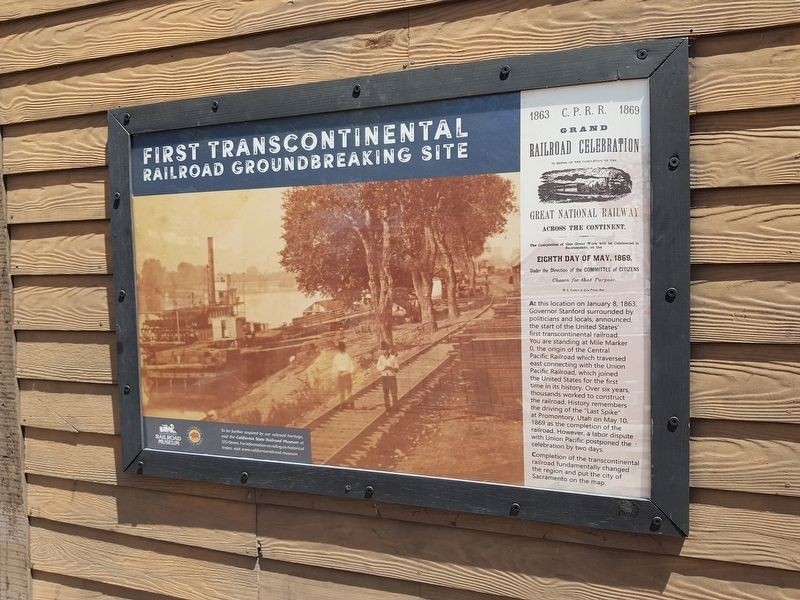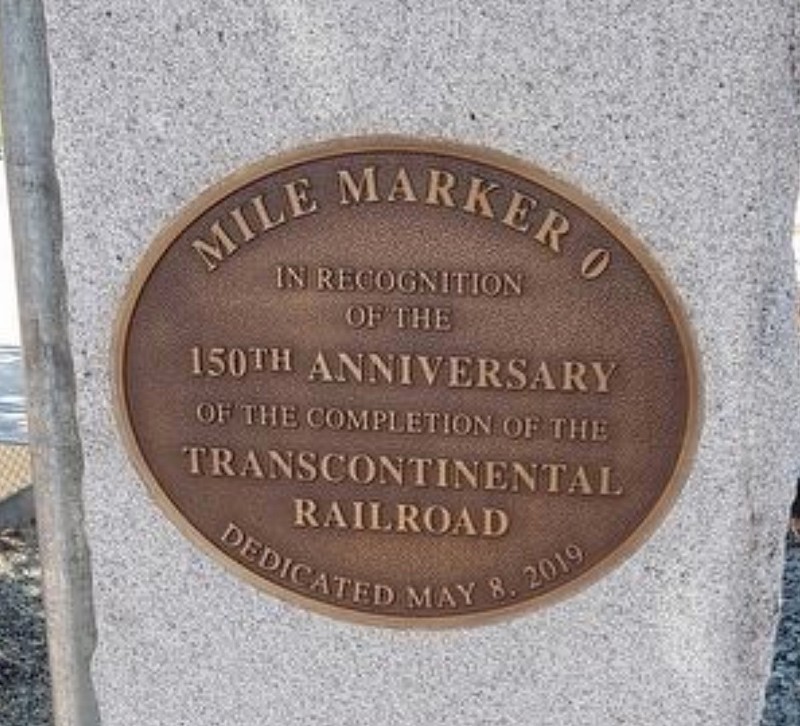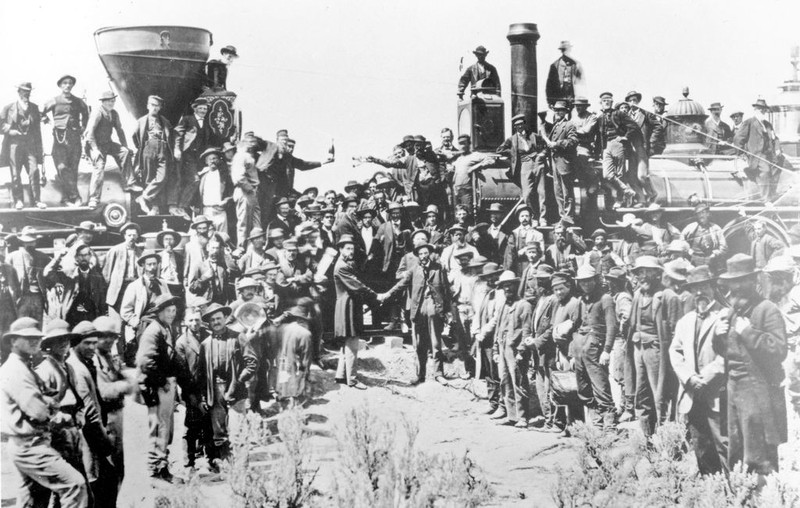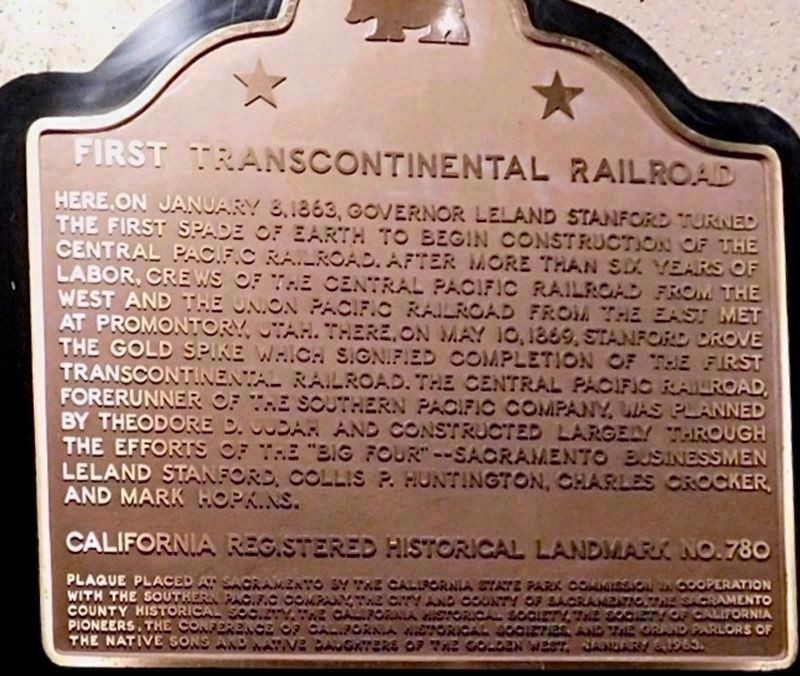First Transcontinental Railroad Groundbreaking Site Historical Marker
Introduction
Text-to-speech Audio
On January 8, 1863, construction began on the first transcontinental railroad across the United States. This historical marker pinpoints the location of "Mile Marker Zero," the groundbreaking site for the Central Pacific Railroad, which was extended east towards a point of convergence with the Union Pacific Railroad, which was extended west. The project took six years and thousands of workers to complete, costing many laborers their lives due to the dangerous conditions. Upon completion of the ambitious project, the nation was connected by a contiguous railroad for the first time in history. On May 8, 1869, a grand celebration was held in Sacramento, further boosting the city's national identity.
Images
"First Transcontinental Railroad Groundbreaking Site" Historical Marker in Sacramento, CA

"Mile Marker Zero," the groundbreaking site in Sacramento where west-to-east construction commenced in 1863 by Central Pacific Railroad workers

Hammering in the "Golden Spike" in Promontory, Utah, in 1869, officially completing construction of the First Transcontinental Railroad, as the Central Pacific and Union Pacific Railroad lines were joined.

The First Transcontinental Railroad Marker, located inside the nearby California State Railroad Museum, where visitors can learn more about this history.

Backstory and Context
Text-to-speech Audio
Prior to the construction of the first transcontinental railroad from 1863 to 1869, overland travel by stagecoach, wagon, or horseback was time consuming, costly, and dangerous. In the mid-19th century, the only other options were to travel by ship around the southern tip of South America, or to sail down the coast of North America and travel by land over the Isthmus of Panama (the Panama Canal did not exist until 1904) and then sail north up the other coast. Journeys such as these could take months, requiring hundreds or even thousands of dollars. They often cost travelers their lives, due to poor conditions, disease, extreme weather, and other unexpected events.
The first transcontinental railroad began as an ambitious plan to connect the existing eastern U.S. railway lines to the West Coast. Initially known as the "Pacific Railroad," the plan was to create a contiguous railroad across the U.S., while dramatically accelerating the speed of overland travel and forging new routes through harsh and difficult terrain. Several prominent voices promoted the idea, recognizing its value for business and industry. In 1852, Theodore Judah, the chief engineer for the Sacramento Valley Railroad, surveyed the Sierra Nevada Mountains to locate a potential passage through the high peaks. After Judah presented his proposal to Congress in 1856, Congress passed the Pacific Railroad Act (1862 and 1864), authorizing the expansion of the Central Pacific and Union Pacific Railroads.
Thousands of laborers were hired to complete the arduous task of laying 2,000 miles of new tracks for what came to be known as the Great Transcontinental Railroad or "The Overland Route." Chinese workers for the Central Pacific Railroad Company built new tracks eastward from Sacramento, California, while Irish and German workers for the Union Pacific Railroad Company set down tracks going west from Omaha, Nebraska, until the two lines were joined in the middle. By the end of the 1860s, the project involved the combined efforts of Chinese and European immigrants, recently emancipated African Americans, and former soldiers for both the Union and Confederate armies. Pack animals were also used for carting tools and supplies.
The work was especially difficult for the Central Pacific Railroad employees who had to lay new tracks through the Sierra Nevadas. Chinese immigrants worked three shifts around the clock, drilling holes by hand for explosives to create tunnels through the mountains. Progress was roughly one foot per day. Numerous workers died or were injured due to explosions, extreme weather, and mountain avalanches. One account by Mintz and McNeil described how workers were "lowered in hand-woven reed baskets to drill blasting holes in the rock ... and were hopefully pulled up before the powder was detonated."
Finally, on May 10, 1869, a golden spike was hammered into the last railway tie, which was laid in Promontory, Utah, officially joining the Central Pacific and Union Pacific railway lines and completing the construction of the First Transcontinental Railroad across the United States. Celebrations were held in various places, as in Sacramento where construction had begun in 1863 on the Central Pacific line. Goods could be shipped across the country at a fraction of the previous time. The extension of the railroad also meant increased mobility for people, as settlers from other parts of the country, and immigrants from Europe and elsewhere, rushed to establish homesteads on land that the U.S. had otherwise considered inaccessible.
From beginning to end, however, the project was not without its share of bribery, corruption, and scandal among investors. Many laborers were also exploited in the process, particularly the Chinese immigrants who were underpaid while being subjected to some of the harshest conditions. When they tried to strike for better wages, their food was withheld. The expansion of the railroad also negatively impacted Native Americans, encroaching on land and fueling the slaughter of indigenous people, as well as herds of bison throughout the plains region, by the U.S. Army. Even for the United States, the transcontinental railroad and its resulting effects altered the nation so completely that by 1890, the "American frontier" was declared to be a thing of the past.
Sources
Bruton, J. Makali. "First Transcontinental Railroad Groundbreaking Site Historical Marker", Historical Marker Database. July 1st, 2017. Accessed July 7th, 2023. https://www.hmdb.org/m.asp?m=149177.
"Completion of the Transcontinental Railroad", Library of Congress, Research Guides. Accessed July 7th, 2023. https://guides.loc.gov/this-month-in-business-history/may/completion-transcontinental-railroad#:~:text=.
Digital Exhibits, California State Railroad Museum. Accessed July 7th, 2023. https://www.californiarailroad.museum/education/digital-exhibits.
Mintz, Steven, and McNeil, Sara. "Building the Transcontinental Railroad", Digital History, University of Houston, 2018. Accessed July 7th, 2023. https://www.digitalhistory.uh.edu/disp_textbook.cfm?smtID=2&psid=3147.
"The Transcontinental Railroad", PBS. January 27th, 2003. Accessed July 7th, 2023. https://www.pbs.org/wgbh/americanexperience/films/tcrr/.
"The Transcontinental Railroad: 1869", Utah State Government. Accessed July 7th, 2023. https://ilovehistory.utah.gov/1869-first-transcontinental-railroad/.
J. Makali Bruton, Historical Marker Database
J. Makali Bruton, Historical Marker Database
Photograph by Andrew Russell / Courtesy of Union Pacific Railroad Co.
J. Makali Bruton, Historical Marker Database
